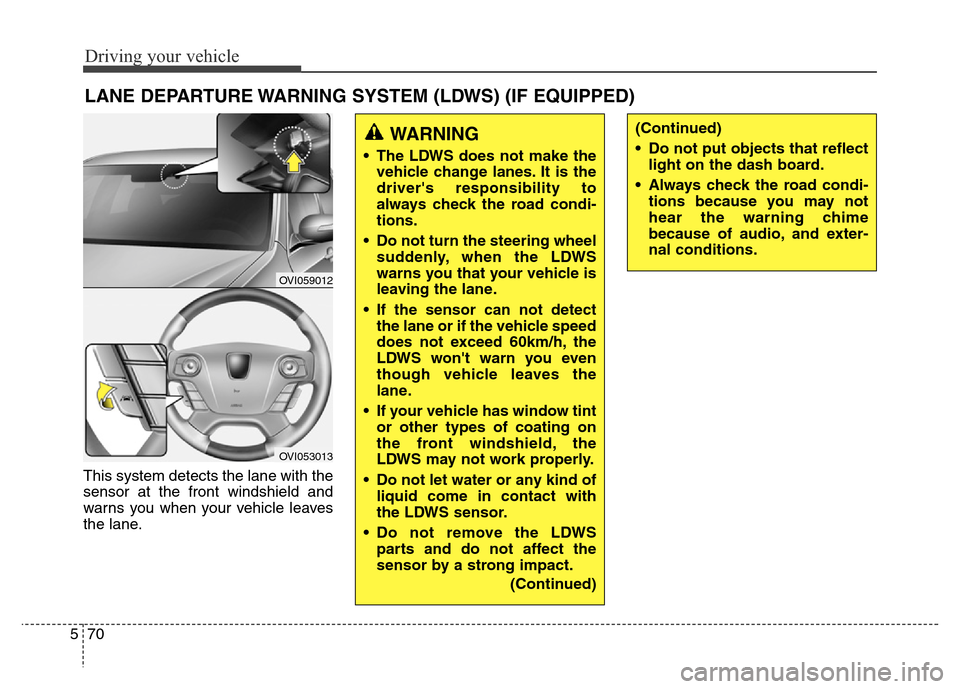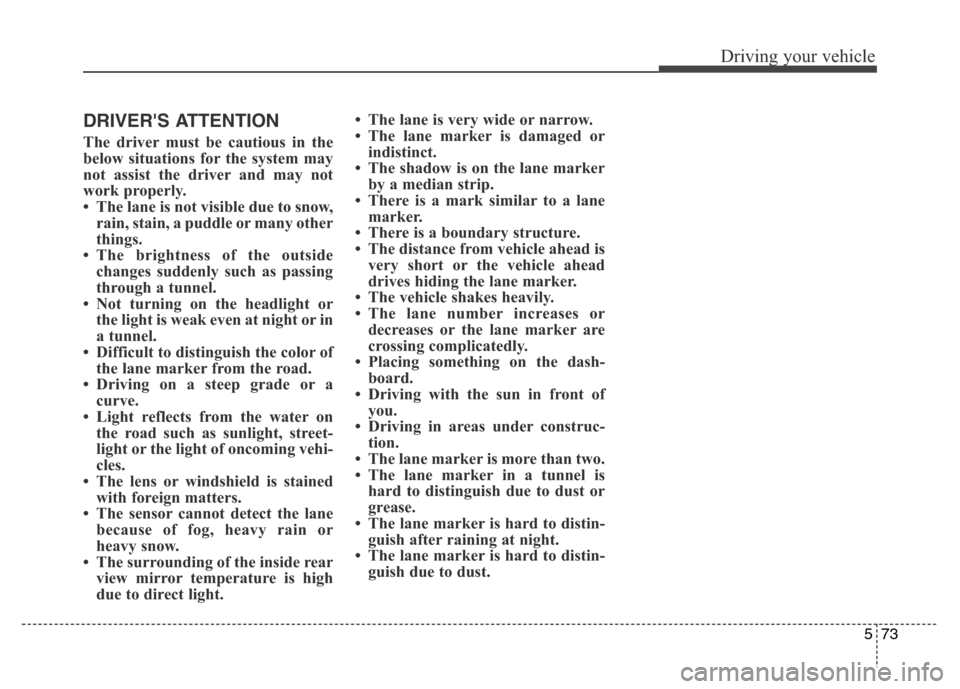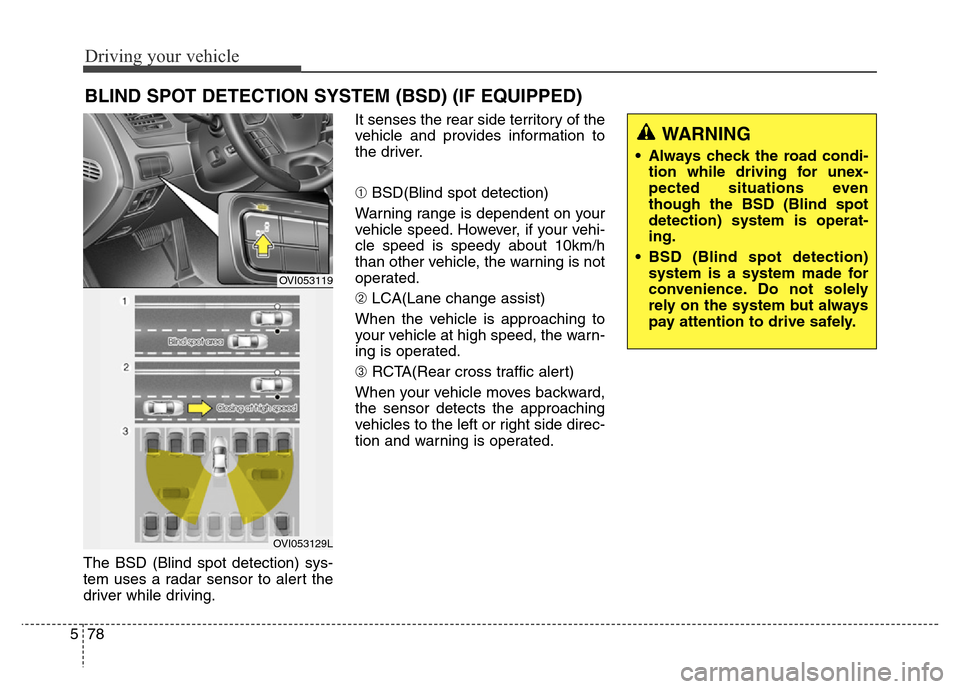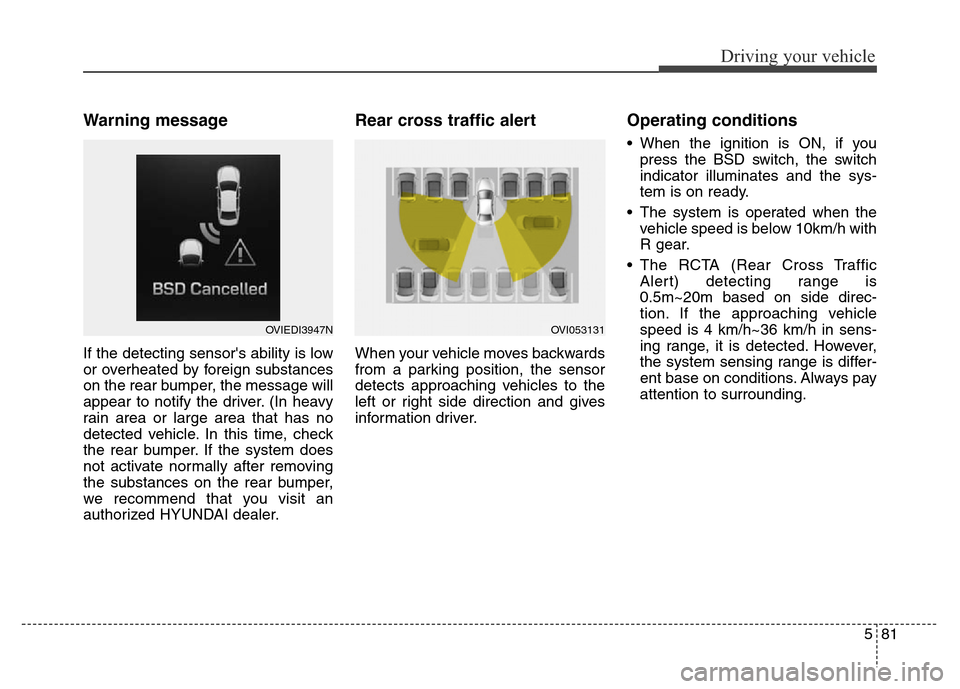Page 327 of 479

Driving your vehicle
70 5
This system detects the lane with the
sensor at the front windshield and
warns you when your vehicle leaves
the lane.
LANE DEPARTURE WARNING SYSTEM (LDWS) (IF EQUIPPED)
OVI059012
OVI053013
WARNING
• The LDWS does not make the
vehicle change lanes. It is the
driver's responsibility to
always check the road condi-
tions.
• Do not turn the steering wheel
suddenly, when the LDWS
warns you that your vehicle is
leaving the lane.
• If the sensor can not detect
the lane or if the vehicle speed
does not exceed 60km/h, the
LDWS won't warn you even
though vehicle leaves the
lane.
• If your vehicle has window tint
or other types of coating on
the front windshield, the
LDWS may not work properly.
• Do not let water or any kind of
liquid come in contact with
the LDWS sensor.
• Do not remove the LDWS
parts and do not affect the
sensor by a strong impact.
(Continued)
(Continued)
• Do not put objects that reflect
light on the dash board.
• Always check the road condi-
tions because you may not
hear the warning chime
because of audio, and exter-
nal conditions.
Page 328 of 479
571
Driving your vehicle
LDWS operation
To operate the LDWS, pull
the switch with the engine
start/stop button in the
ON position. The indicator
(green) illuminates on the
cluster. To cancel the
LDWS, pull the switch
again.
LDWS indicator light illuminates:
• [Green] - When the system operat-
ing conditions are satisfied.
• [White]
- When system operating condi-
tions are not satisfied (When the
vehicle speed is below 60 km/h).
- When the sensor does not detect
the lane line.
• [Yellow] - When there is a malfunc-
tion with the lane departure warn-
ing system. In this case, we recom-
mend that the vehicle be inspected
by an authorized HYUNDAI dealer.
If your vehicle leaves the lane when
the LDWS is operating and vehicle
speed exceeds 60km/h, the warning
operates as follows:
OVIDDR2919
OVIDDR2920
• When the sensor detects the lane line
• When the sensor doesn’t detect the lane line
Page 330 of 479

573
Driving your vehicle
DRIVER'S ATTENTION
The driver must be cautious in the
below situations for the system may
not assist the driver and may not
work properly.
• The lane is not visible due to snow,
rain, stain, a puddle or many other
things.
• The brightness of the outside
changes suddenly such as passing
through a tunnel.
• Not turning on the headlight or
the light is weak even at night or in
a tunnel.
• Difficult to distinguish the color of
the lane marker from the road.
• Driving on a steep grade or a
curve.
• Light reflects from the water on
the road such as sunlight, street-
light or the light of oncoming vehi-
cles.
• The lens or windshield is stained
with foreign matters.
• The sensor cannot detect the lane
because of fog, heavy rain or
heavy snow.
• The surrounding of the inside rear
view mirror temperature is high
due to direct light.• The lane is very wide or narrow.
• The lane marker is damaged or
indistinct.
• The shadow is on the lane marker
by a median strip.
• There is a mark similar to a lane
marker.
• There is a boundary structure.
• The distance from vehicle ahead is
very short or the vehicle ahead
drives hiding the lane marker.
• The vehicle shakes heavily.
• The lane number increases or
decreases or the lane marker are
crossing complicatedly.
• Placing something on the dash-
board.
• Driving with the sun in front of
you.
• Driving in areas under construc-
tion.
• The lane marker is more than two.
• The lane marker in a tunnel is
hard to distinguish due to dust or
grease.
• The lane marker is hard to distin-
guish after raining at night.
• The lane marker is hard to distin-
guish due to dust.
Page 332 of 479
575
Driving your vehicle
AVSM detects the distance from the
vehicle ahead with the sensor, to
warn you before collision and protect
you in certain hazardous situations
by using warning message, warning
sound and seat belt vibration (if
equipped).
• If the AVSM senses the object
ahead too near the vehicle and if
driver's operating of the brake
pedal or the steering wheel should
be needed, the warning light illumi-
nates.
Immediately reduce your speed.
• If the AVSM senses more danger-
ous, the warning sound also oper-
ates and the seat belt vibrates.
Immediately reduce your speed.
ADVANCED VEHICLE SAFETY MANAGEMENT (AVSM) (IF EQUIPPED)
CAUTION
Always check the road condi-
tions to prevent danger even if
the warning light does not illu-
minate, the warning sound does
not operate or the seat belt does
not vibrate.
OVIEDR29101
Page 334 of 479

577
Driving your vehicle
Malfunction indicator
• The VSM OFF indicator will illumi-
nate when the engine start/stop
button is turned ON, but should go
off after approximately 3 seconds.
If the indicator does not come on,
or continuously remains on after
coming on for about 3 seconds
when you turn the engine
start/stop button to the ON posi-
tion, or if the indicator comes on
while driving, the AVSM is not
working properly. We recommend
that the system be checked by an
authorized HYUNDAI dealer.
• The VSM OFF indicator may illumi-
nate when the ESC indicator or
SCC indicator comes on, but it
does not indicate malfunction of
the AVSM.
WARNING
The AVSM is not a substitute for
safe driving practices but a sup-
plementary function only. It is
the responsibility of the driver
to always check the speed and
the distance to the vehicle
ahead.
WARNING
• Even if there is a malfunction
to the brake operating of the
AVSM, when you depress the
brake pedal, the brake is oper-
ating normally. But, the AVSM
brake operating does not
operate even in certain haz-
ardous situations.
• The AVSM is designed to
function above approximately
15 km/h (9.3 mph) and below
approximately 180 km/h (111.8
mph).
• The AVSM does not react to
- Persons or animals.
- Oncoming vehicles in the
opposite lane or the vehicle
in the intersection.
- Stopped objects.
• The AVSM can not detect the
objects certainly, when:
- The sensors are stained with
dirt or covered.
(Continued)
(Continued)
- There is heavy rain or heavy
snow.
- There is interference by elec-
tromagnetic waves.
- There are strong radar
reflections.
- Driving in curve.
- Driving uphill or downhill.
- Driving in areas under con-
struction.
- The object ahead is very nar-
row such as motorcycles or
bicycles.
- The vehicle cuts in suddenly.
• The AVSM brake operating
does not operates, if the driv-
er does not release the accel-
erator pedal or does not oper-
ate the brake pedal.
Page 335 of 479

Driving your vehicle
78 5
The BSD (Blind spot detection) sys-
tem uses a radar sensor to alert the
driver while driving.It senses the rear side territory of the
vehicle and provides information to
the driver.
➀BSD(Blind spot detection)
Warning range is dependent on your
vehicle speed. However, if your vehi-
cle speed is speedy about 10km/h
than other vehicle, the warning is not
operated.
➁LCA(Lane change assist)
When the vehicle is approaching to
your vehicle at high speed, the warn-
ing is operated.
➂RCTA(Rear cross traffic alert)
When your vehicle moves backward,
the sensor detects the approaching
vehicles to the left or right side direc-
tion and warning is operated.
BLIND SPOT DETECTION SYSTEM (BSD) (IF EQUIPPED)
OVI053119
OVI053129L
WARNING
• Always check the road condi-
tion while driving for unex-
pected situations even
though the BSD (Blind spot
detection) system is operat-
ing.
• BSD (Blind spot detection)
system is a system made for
convenience. Do not solely
rely on the system but always
pay attention to drive safely.
Page 337 of 479
Driving your vehicle
80 5
The second stage alarm will activate
when:
1.The first stage alert is on
2.The turn signal is on to change a
laneWhen the second stage alert is acti-
vated, a warning light will be blinking
on the outside rearview mirror and
the head up display, and a alarm will
sound.
If you move the turn signal switch to
origin position, the second stage
alert will be deactivated.
Detecting sensor
The sensors are located on inside of
the rear bumper.
Always keep the rear bumper clean
for the system to work properly.
OVI053121
OVI053122
2nd stage
OVI053130
Page 338 of 479

581
Driving your vehicle
Warning message
If the detecting sensor's ability is low
or overheated by foreign substances
on the rear bumper, the message will
appear to notify the driver. (In heavy
rain area or large area that has no
detected vehicle. In this time, check
the rear bumper. If the system does
not activate normally after removing
the substances on the rear bumper,
we recommend that you visit an
authorized HYUNDAI dealer.
Rear cross traffic alert
When your vehicle moves backwards
from a parking position, the sensor
detects approaching vehicles to the
left or right side direction and gives
information driver.
Operating conditions
• When the ignition is ON, if you
press the BSD switch, the switch
indicator illuminates and the sys-
tem is on ready.
• The system is operated when the
vehicle speed is below 10km/h with
R gear.
• The RCTA (Rear Cross Traffic
Alert) detecting range is
0.5m~20m based on side direc-
tion. If the approaching vehicle
speed is 4 km/h~36 km/h in sens-
ing range, it is detected. However,
the system sensing range is differ-
ent base on conditions. Always pay
attention to surrounding.
OVIEDI3947NOVI053131